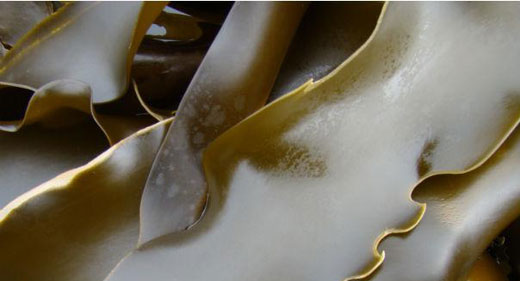by Nick English: You’ve likely chewed on seaweed wrapped around a sushi roll, but few Westerners would consider picking up a bag of the stuff at the grocery store. It might be time for a change: Seaweed is filled with antioxidants, calcium, and a broad range of vitamins, but that doesn’t begin to scratch the slippery brown surface of this fascinating food.

WHY IT’S SUPER
A member of the algae family, edible seaweed typically comes in three varieties: brown, red, and green. The most commonly eaten (and researched) are the brown varieties such as kelp and wakame, followed by red seaweed, which includes nori (yep — that’s what most sushi chefs use).
While seaweed-based cuisine has a proud history in many Asian countries, Japan has made it into an art form, employing over twenty different species in their fare. In a restaurant, you’re most likely to consume seaweed in a small kelp (kombu) salad, simmered into miso soup, or wrapped around a sushi roll.
At just two tablespoons per serving, it’s true that seaweed isn’t a realistic source of many vitamins, and its benefits can occasionally be exaggerated. Seaweed contains vitamins A and C, and is also a source of calcium, which is one of the reasons some red seaweed supplements are included as part of some treatment plans for osteoarthritis. However, serving sizes are often not large enough to get a decent boost in these nutrients.
Seaweed’s best-known benefit is that it is an extraordinary source of a nutrient missing in almost every other food: iodine. Consuming healthy levels of iodine is critically important to maintaining a healthy thyroid, a gland in your neck which helps produce and regulate hormones. A malfunctioning thyroid can result in a wide range of symptoms such as fatigue, muscle weakness, and high cholesterol (to name a few). In severe or untreated cases, it can lead to serious medical conditions like goiters (a swelling of the thyroid gland), heart palpitations, and impaired memory.
Since manufacturers started adding iodine to salt in the 1920s and the World Health Organization adopted a worldwide salt iodization program in 1993, symptoms of extreme iodine deficiency have largely disappeared. However, for a host of reasons, including iodine-blocking chemicals in our environment, the poor quality (i.e. iodine-free) salt used in processed foods, and a general trend of salt-ophobia among health conscious folks, mild iodine deficiency is once again becoming increasingly common.
The trouble with mild iodine deficiency is that it can manifest very subtly. Fatigue, depression, a higher susceptibility to diseases, difficulty losing weight — these can all result from an underactive thyroid, and if the symptoms sound a little familiar, it’s not hard to test yourself. But if you’re keen to avoid thyroid drama (which, by the way, is especially important if you’re pregnant), noshing on some seaweed could help: One gram of brown seaweed contains roughly five to 50 times the recommended daily intake, while red and green varieties provide slightly less (the exact iodine content depends on the water in which it’s grown).
The benefits of this sea green extend far beyond basic nutrition: Research suggests seaweed can also help regulate estrogen and estradiol levels — two hormones responsible for proper development and function of sexual organs — potentially reducing the risk of breast cancer. In fact, some claim Japan’s high seaweed consumption is responsible for the country’s conspicuously low incidence of the diseases. For the same reasons, seaweed may also help to control PMS (men, rejoice!) and improve female fertility issues.
And many studies studies have shown seaweed is an extraordinarily potent source of antioxidants and also helps prevent inflammation, which can contribute to a host of ailments that include arthritis, celiac disease, asthma, depression, and obesity .
YOUR ACTION PLAN
Before adding seaweed to all of your meals, consider that — despite it’s potential benefits — this sea vegetable can be troublesomely healthy. Ten grams (roughly two tablespoons) of dulse, a type of red seaweed, has 34 times the amount of potassium in an equally sized serving of banana — a high enough dosage to cause heart palpitations among people with kidney problems (though it should generally be safe for those without preexisting conditions).
Similarly, while the thyroid malfunctions without iodine, research suggests too muchof the stuff can have its own side effects. The answer lies, as always, in moderation — one two-tablespoon serving of brown seaweed every week will provide a happy medium, while nori’s lower iodine content means you’re free to enjoy a few rolls of sushi every week, if you wish.
It’s also worth remembering that if the water the seaweed comes from is contaminated (with, say, toxic metals or arsenic), the seaweed will be as well . The US Food and Drug Administration regulates commercial seaweed, and they have pretty high safety standards, but it’s important to note that the FDA does not regulate supplements. So if you’re taking seaweed pills, it’s important to choose a reputable brand. Speak with your physician before you decide on supplements — the metals in some seaweed pills could send you to the hospital, and they can be especially to dangerous to pregnant women and their babies.
With the right accompaniments, seaweed can be a flavorful component with a healthy dose of antioxidants and iodine — just try not to eat an ocean’s worth.
Do you have a favorite way to eat seaweed, or do you think we should steer clear of the stuff? Let us know below!























































